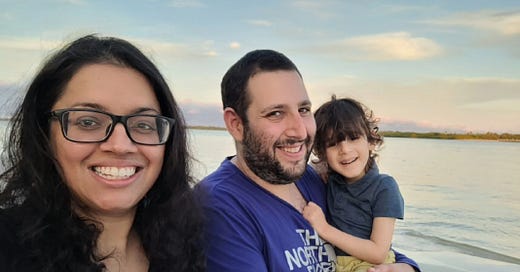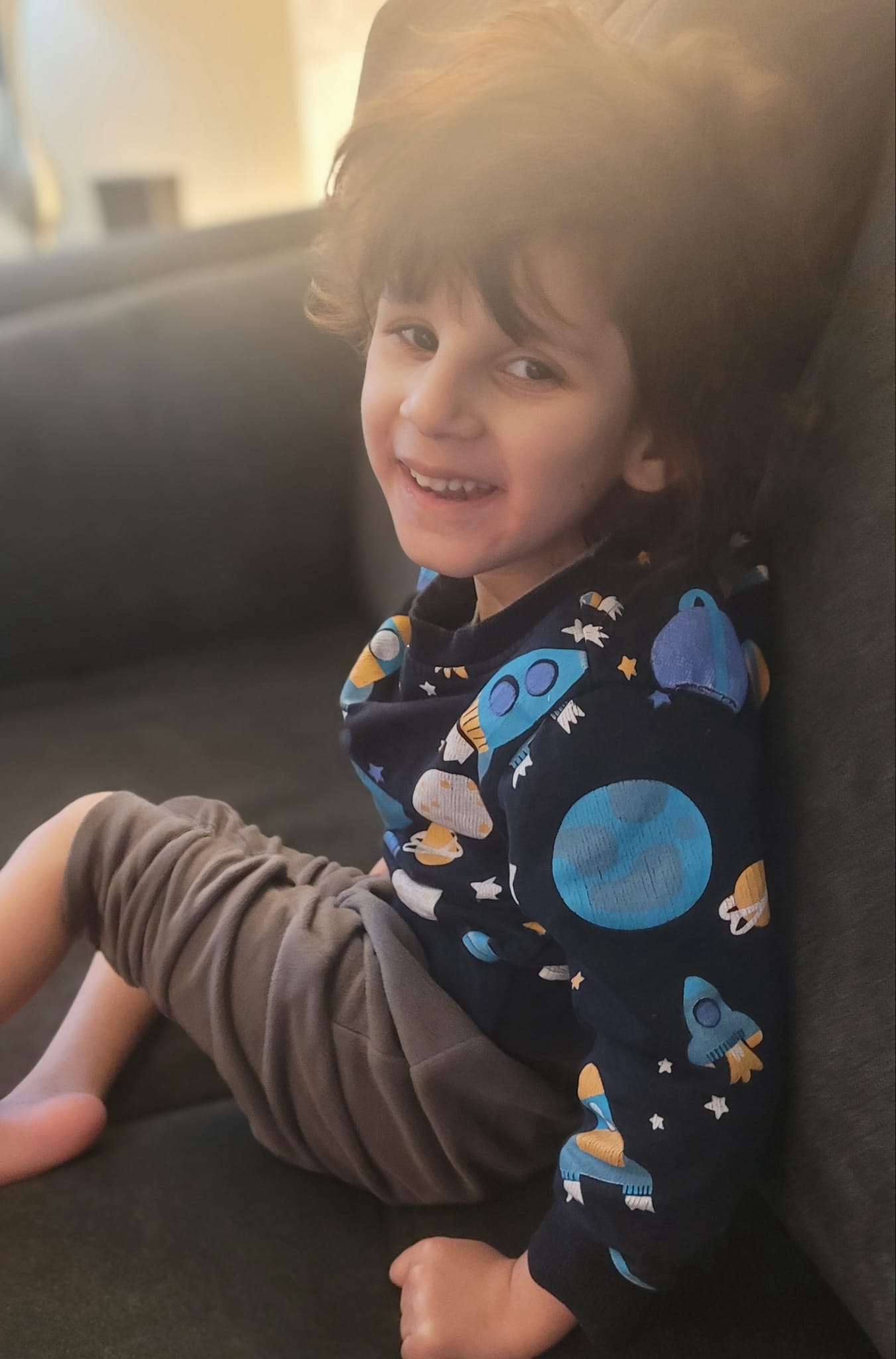Happy 5th Birthday, Riaan! Send a birthday message to Riaan through his Kudoboard here. Riaan and his entire family deeply cherish and thank you for your kind sentiments.
by Jo Kaur and Richie Digeorge, Riaan’s Parents and Co-Founders of Riaan Research Initiative
(December 12, 2024) - A Happy Holidays to all! We hope everyone is enjoying a merry and festive time with their loved ones.
Today, we’d also like to wish a very Happy Birthday to our beloved son, Riaan.
Riaan was diagnosed with Cockayne syndrome (“CS”) on March 12, 2021. His resilience, strength, and infinite magic inspired us to launch Riaan Research Initiative just three months later, in June 2021, to accelerate the development of treatments for this terrible disease.
When Riaan was first diagnosed, we were given utterly terrible news. We were told his life expectancy is 5 to 7 years based on his type (Type 2, severe). While we now understand the disease to be more of a spectrum, with less clear timelines, we have been racing against the clock to fund the development of treatments, and to try and save his life and that of other impacted children.
We have lived in fear of Riaan turning five but we are instead choosing to view this birthday as a rare and miraculous opportunity, a chance that did not exist before. Riaan’s 5th year is the one where we hope that scientists and physicians will be able to administer the first gene therapy to a child diagnosed with Cockayne syndrome.
Gene Therapy Update
Our signature research project is propelling and funding the research to develop a gene therapy for Cockayne syndrome, specifically for CSA/ERCC8 mutations, at the University of Massachusetts Chan Medical School. This multi-million dollar undertaking is funded entirely by Riaan Research Initiative, and through the exceptional generosity of our donors. Scientists at UMass Chan have already proven that the gene therapy is effective and safe in mice suffering from severe Cockayne syndrome. Scientists and researchers are now in the process of proving that the gene therapy is safe in rats - a formal toxicology study - and simultaneously manufacturing a clinical grade drug that can be administered to children. We are hopeful that we will be able to apply for an Investigational New Drug (“IND”) application with the U.S. Food and Drug Administration (“FDA”) and dose the first child in 2025. To prepare for this, we are putting together a comprehensive team of experts and consultants, along with legal counsel, to strengthen our application, and oversee any regulatory hurdles we may face.
However, the work doesn’t stop there. The next phase of our project is to ensure that we can fully fund the first clinical trials, and to continue to be able to provide the gene therapy, once hopefully approved by the FDA for use in these trials, to as many impacted children as possible. The next phases are only possible through continued donations, and will require significant funding.
Drug Repurposing Update
Riaan Research Initiative also launched two major drug repurposing studies, one of which is still ongoing, costing in the hundreds of thousands of dollars. While neither study delivered the immediate results we desired: there were no drugs that could be repurposed right away - or prescribed straight from a pharmacy shelf to our children - the results still revealed that we could make notable impact in the pathways of a lethal disease, which was an exciting and promising scientific breakthrough.
Our first drug screen was with Rarebase (now known as Transcripta Bio) and was more limited in scope, cost, and the gene of focus (CSA/ERCC8 only). The screen positively identified a variety of drugs that could increase expression of CSA/ERCC8 genes in healthy neurons (glutamatergic neurons) without Cockayne syndrome, ranging from drugs usually prescribed for immunodeficiencies, mental health disorders, and even Vitamin B12. Follow up analysis demonstrated that it was unlikely the drugs would benefit patients with complete loss of function in their CSA/ERCC8 genes: in other words, if the CSA gene is mutated to the point that it does not generate any CSA protein, then no drug is likely going to increase expression of that CSA gene. However, there is a possibility that some benefit could be achieved in patients who have some, even minimal function, which is the case for a number of CS children.
While there is no clear genotype-phenotype relationship in CS, some researchers believe that increasing even a small bit of expression, if possible, in CSA or CSB (the other gene primarily mutated in children with CS), could improve symptoms, assuming that the drug is not toxic or unsafe for those with a DNA repair disorder. Due to a lack of funding and changes in budgeting priorities, however, we were unable to follow up with this hypothesis or explore whether alternate pathways exist that could bolster gene expression in other genes in the DNA repair pathway to compensate for a complete lack of CSA protein. Nonetheless, the information and lessons from this work were extrapolated to our bigger drug repurposing screen with Charles River Laboratories, and Leiden University Medical Center, and described below.
This comprehensive 5,685 compound drug screen from the SPECS repurposing library, the first of its kind ever done for Cockayne syndrome, positively identified dozens of drugs that could effectively inhibit ATF3, an early transcriptor gene which is potentially responsible for 5000 other genes, and is activated specifically in Cockayne Syndrome patients with CSA/ERCC8 or CSB/ERCC6 mutations. ATF3, when activated, is known to downregulate at least six genes that impact neuronal activity and cause microcephaly and sensory motor neuronal delays. Underexpression of these genes have been linked to phenotypes (symptoms) commonly seen in CS children.
The CSA and CSB proteins, when functioning appropriately, help degrade ATF3 but in CS patients, they cannot perform this task leaving ATF3 on so to speak. While there are drugs that inhibit ATF3, as identified by our drug screen, scientists at Leiden University Medical Center are still exploring whether they can be used safely in children as many of them are highly potent anti-cancer drugs or in Phase II/Phase III clinical trials making them less accessible. They are also determining whether additional testing must be done in animal models to calculate safe but effective dosing levels. This work is ongoing, and may require additional funding.
***
We’ve learned through the foundation that developing treatments for a rare disease will always be arduous and continuous work, a perpetual mission in progress. We’ve purchased the land, we’ve established the foundation, but we still need to build the house, design the backyard, furnish it, and fund its residents for years to come. The analogy becomes murky after a bit but the point hopefully survives.
Whenever we describe the non-profit to relevant partners - the “elevator pitch” - we always start by saying: “We were borne of necessity, a volunteer-driven initiative of desperate parents trying to do what they can to build hope for their child and community,” a phrase likely true of many rare disease patient advocacy organizations. Even still, as we reach this time of Riaan turning five, we are taken back by all of the work and discoveries made possible over the last few years, all because our community united with us to demand a commitment from researchers to build the treatments our children deserve, with the urgency the situation demands. This is truly a grassroots, community-fueled effort, powered by love and of course resources, to develop potentially life-saving treatments for our beautiful, unforgettable children.
We cannot thank you enough for joining us on this journey, with Riaan, and for driving these revolutionary scientific advancements in combating Cockayne syndrome.
This is, indeed, the time of miracles. We are excited about what lies ahead. Happy birthday, dear Riaan. We are so proud of you for what you’ve inspired.
To Riaan, From Dad
My Dear Riaan,
12/12 is a day that changed my life forever. It was the day you were introduced to this world. I've seen you grow to the wonderful big brother that you are. To be very honest with you, this birthday has scared me. The doctors when you were diagnosed told us that you wouldn't make it to this age. However, you continue to surprise everyone and keep improving every day. I'm so proud of you. You're not only an inspiration to your dad but to the whole community. I shouldn't expect anything less from you. Your smile is contagious and your simple presence brightens rooms. Lu, your baby brother, also looks up to you, he doesn't want to be anywhere without you. I love you Riaan, keep doing what you're doing. You’re changing the world for the better. I'm honored to have you as my son. Happy 5th birthday and knowing you, we'll have many more to come.
Love, Dad
To Riaan, From Mom
My Darling Riaan:
Happy, happy birthday. For you, I live. For you, I fight. For you, I grow. You are the colors in the rainbow, the coolness of the breeze, the warmth of the sun, and the mystery of the sea. There’s nothing I wouldn’t do for you.
Here’s to many more birthdays.
Love, Mom
***
Help us raise $5,000 to celebrate Riaan turning 5! Donate here, or through Instagram and Facebook.





